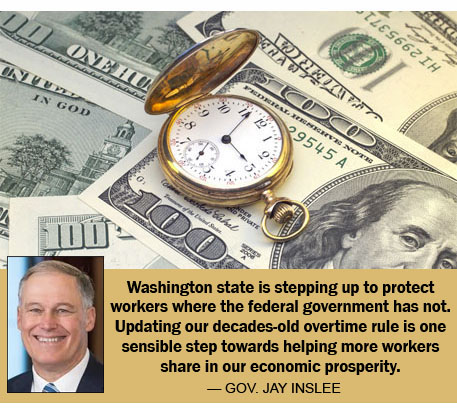STATE GOVERNMENT
Overtime pay comment period ends; final rule coming in Dec.
The Trump administration will announce a plan today that’s ‘way too weak’ to restore 40-hour work week.

TUMWATER (Sept. 24, 2019) — The public comment period for the proposed update to Washington’s overtime rules has ended. The state Department of Labor & Industries (L&I) reports that it has received thousands of public comments.
L&I took public input for more than three months after announcing the proposal in early June. The state agency is now reviewing each of the public comments as it considers all aspects of the proposed changes to the state’s overtime rules. A final decision is expected in early December.
L&I’s proposal, supported by Gov. Jay Inslee, is to gradually increase the overtime salary threshold, under which all workers in the state must be paid time-and-a-half for working beyond a 40-hour workweek, to 2.5 times the state minimum wage by 2026. Under the proposal, seven years from now, anyone making less than about $80,000 per year, regardless of whether they are classified as hourly or salaried employees, would get time-and-a-half pay beyond 40 hours per week. That would restore overtime pay eligibility to an estimated 250,000 employees in Washington.

The current salary threshold, which has not been updated for decades to adjust for inflation, is just $23,660 per year. That’s less than what a full-time minimum wage worker in Washington earns. Anyone who earns more than $23,660 can be declared “exempt” salaried employees and forced to work additional hours beyond 40 per week for free. In the decades that salary threshold has been frozen, the percentage of salaried American workers eligible for overtime pay has gone from more than 60% in the 1970s to less than 7% today.
“As working families struggle to pay the bills, they have been working longer and longer hours, sometimes for free because of our outdated overtime pay rules,” said Larry Brown, President of the Washington State Labor Council, AFL-CIO. “This update is badly needed so companies can’t exempt so many workers from the 40-hour workweek. It will mean extra pay for some, but importantly, it will help many people in Washington get their time back, too.”
Meanwhile, the Trump administration is expected to announce today his plan to dramatically scale back an Obama-era rule to update the federal salary threshold for overtime exemption. Trump’s U.S. Department of Labor will propose to raise the threshold for overtime pay exemption from to just $35,568/year. That means workers who make more than that amount can be declared “exempt” salaried employees and forced to work additional hours beyond 40 per week for free.
Obama’s 2016 federal rule increased that salary threshold to about $47,500 before it was derailed by a legal challenge from Republican state attorneys general and a federal judge in Texas. Had the Obama rule, which provided for automatic inflationary updates of the threshold, remained in place, the threshold would be $51,064 today and $55,000 in 2022.
An analysis suggests that millions of Americans — well over half of the workers who would have gotten new or strengthened overtime protections under Obama’s 2016 rule — will be left behind by Trump administration rule.
“The Trump administration’s proposal is way too weak and totally insufficient to restore the basic protections of the 40-hour work week,” Brown said. “Because the overtime pay protections have been allowed to erode for decades, millions of Americans have been forced to work longer and longer hours without extra pay. If everyone who makes just $35,000 per year can be denied extra pay, it’s like their time doesn’t count.”
Polling shows that a super-majority of Washington’s voters support L&I’s plan. The poll, conducted by Patinkin Research Strategies this summer, found that 67 percent of likely 2020 voters support the plan to restore overtime protections to more than 250,000 of Washington’s salaried workers by restoring the threshold to 2.5 times the state minimum wage. That two-thirds approval is universal across every Washington media market, indicating strong statewide, bipartisan support. In fact, 75 percent of independents support the proposal, as well as 45 percent of Republicans, with about 1-in-5 Republicans undecided.
that a super-majority of Washington’s voters support L&I’s plan. The poll, conducted by Patinkin Research Strategies this summer, found that 67 percent of likely 2020 voters support the plan to restore overtime protections to more than 250,000 of Washington’s salaried workers by restoring the threshold to 2.5 times the state minimum wage. That two-thirds approval is universal across every Washington media market, indicating strong statewide, bipartisan support. In fact, 75 percent of independents support the proposal, as well as 45 percent of Republicans, with about 1-in-5 Republicans undecided.
The three-month public comment period on the rule ended Sept. 20 and L&I is now reviewing each of the comments as it considers all aspects of the proposed changes to the state’s overtime rules.
During the public comment period on the proposal, members of the public submitted 2,266 comments. In addition, an estimated 625 people attended, and more than 180 people testified at one of seven public hearings held in July and August in Tumwater, Seattle, Bellingham, Ellensburg, Kennewick, Spokane and Vancouver.
For more information on the rule change process, go to www.Lni.wa.gov/OvertimeRulemaking.





